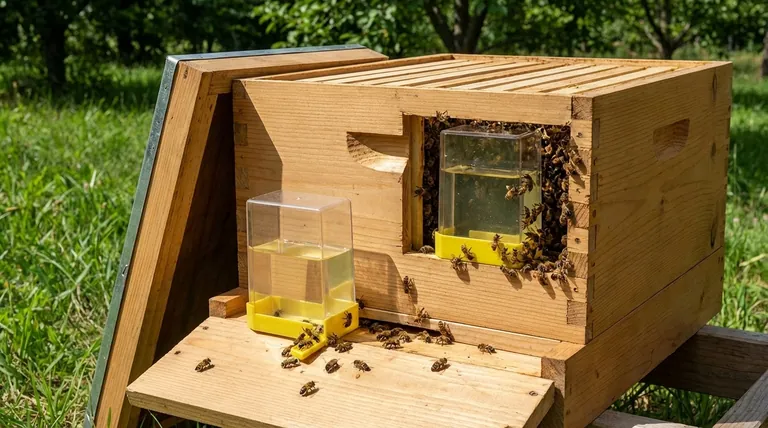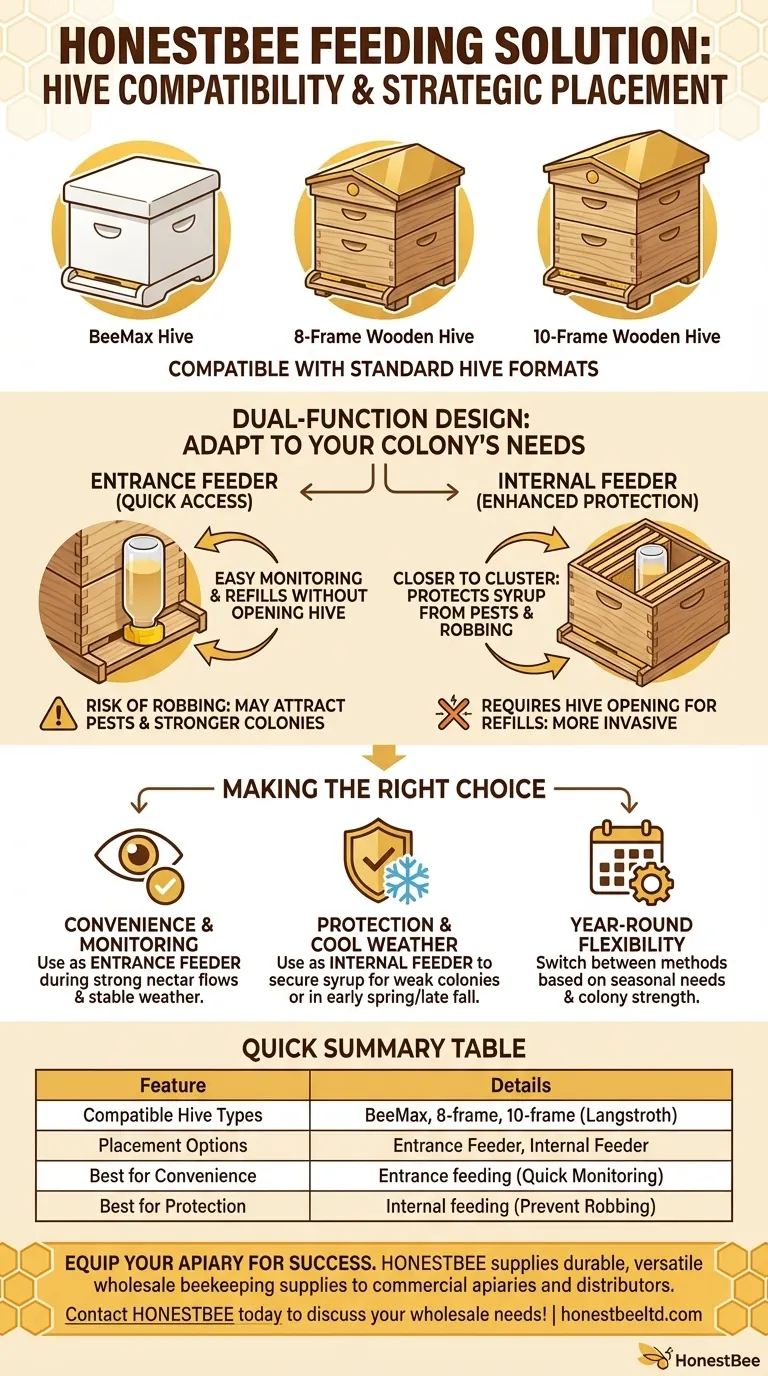This bee feeding solution is designed for versatility. It is directly compatible with the most common hive bodies used by hobbyists and professionals alike, including BeeMax hives, standard 8-frame wooden hives, and 10-frame wooden hives. Its true flexibility, however, comes from its ability to be deployed in two distinct ways: as an entrance feeder or as an internal feeder.
While the feeder fits standard hive models, the crucial decision isn't the type of box you use. The real choice is understanding when to use it as an entrance feeder versus an internal feeder to best meet your colony's seasonal needs.

Understanding Compatibility Beyond Hive Type
The question of physical fit is only the first step. True compatibility is about how the feeder integrates with your beekeeping practices and supports the health of your colony.
The Standard Hive Formats
The feeder is built to accommodate the industry-standard dimensions of modern Langstroth-style hives.
This includes 8-frame and 10-frame wooden hives, which are the most prevalent configurations in beekeeping. It also fits BeeMax hives, which are a popular brand of polystyrene hives that follow these same standard measurements.
The Critical Factor: Feeder Placement
More important than the hive brand is the feeder's dual-function design. It can be placed at the front of the hive or inside one of the hive bodies.
This adaptability allows you to change your feeding strategy based on the time of year, the strength of your colony, and specific environmental pressures.
Choosing Your Feeding Method: Entrance vs. Internal
Each placement method serves a different purpose and offers distinct advantages. Understanding these differences is key to using the feeder effectively.
Using It as an Entrance Feeder
Placing the feeder at the hive entrance allows you to monitor syrup levels and refill the reservoir without opening the hive.
This method minimizes disturbance to the colony, making it a convenient option for routine feeding during stable weather.
Using It as an Internal Feeder
Placing the feeder inside the hive, typically in place of one or two frames, puts the food source closer to the bee cluster.
This protects the syrup from outside pests and, most importantly, prevents robbing from bees in neighboring hives. It is the preferred method for feeding in early spring, late fall, or supporting a weaker colony.
Understanding the Trade-offs
No feeding method is perfect for all situations. Being aware of the potential downsides is critical for responsible hive management.
The Risk of Entrance Feeding
While convenient, an entrance feeder can act as a beacon for robbers. The scent of sugar syrup at the entrance may attract wasps, hornets, and bees from stronger, nearby colonies.
This can lead to fighting at the hive entrance, creating stress and potentially overwhelming a smaller colony.
The Challenge of Internal Feeding
Using the solution as an internal feeder offers better protection but requires you to open the hive for every refill.
This repeated disruption can chill the brood on cool days and agitate the colony. It requires a more invasive management style compared to the simple "check and fill" of an entrance feeder.
Making the Right Choice for Your Colony
Your decision should be guided by the specific goal you are trying to achieve for your bees at a given time.
- If your primary focus is convenience and quick monitoring: Use it as an entrance feeder during strong nectar flows or stable weather, but remain vigilant for signs of robbing.
- If your primary focus is protecting a weak colony or feeding in cooler weather: Use it as an internal feeder to keep the syrup secure and closer to the bee cluster.
- If your primary focus is year-round flexibility: Recognize that this feeder's value is its ability to switch between methods as the season and your colony's needs change.
By understanding both placement methods, you can adapt your feeding strategy to ensure your colony's long-term health and productivity.
Summary Table:
| Feature | Details |
|---|---|
| Compatible Hive Types | BeeMax, 8-frame wooden, 10-frame wooden (Langstroth-style) |
| Feeder Placement Options | Entrance Feeder, Internal Feeder |
| Best for Convenience | Entrance feeding for quick monitoring |
| Best for Protection | Internal feeding to prevent robbing in weak/cool weather |
Equip your apiary with the right tools for success. The right feeding strategy is crucial for colony health and honey production. HONESTBEE supplies durable, versatile beekeeping supplies and equipment to commercial apiaries and beekeeping equipment distributors through our wholesale-focused operations. Let us help you build a more resilient and productive operation.
Contact HONESTBEE today to discuss your wholesale needs!
Visual Guide

Related Products
- Professional Hive Front Entrance Bee Feeder
- Professional Hive Top Bee Feeder for Beekeeping
- Boardman Entrance Bee Feeder Durable Galvanized Steel and Wood Construction for Beekeeping
- HONESTBEE Entrance Bee Feeder Professional Hive Nutrition Solution for Beekeeping
- In-Hive Dual Compartment Frame Bee Feeder for Targeted Colony Nutrition
People Also Ask
- What is an entrance feeder and how is it used? Avoid the Critical Risk of Robbing
- Are entrance feeders good for bees? Prioritize Hive Health Over Convenience
- How does the entrance feeder method work? A Guide to Simple But Risky Hive Feeding
- How do you make an entrance feeder for bees? A Guide to Safe & Effective Hive Feeding
- How does a beehive entrance feeder work? A Simple Guide to Supplemental Feeding



















